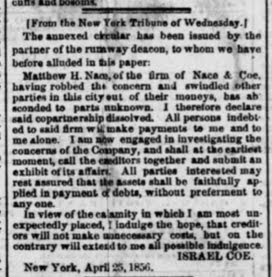 |
| Nace Monument photo taken by Mike Ruble on July 28, 2018 |
Some background: Matthew Harvey Nace was one of four sons of William Nace (6 Feb 1797—May 1863): William M. Nace (19 Sept. 1826-2 Oct 1908), Matthew H. Nace (1824-?), Robert M. Nace (1835-?), and John C. Nace (22 Nov 1828-17 Feb 1928). William Nace worked for Col. Matthew Harvey, so it's logical where Matthew Harvey Nace got his name.
John C. Nace, stayed home (except for his service in the 22nd Virginia infantry during the Civil War). But the other sons all left home.
William Nace Jr. had worked in Richmond at a wholesale grocery and commission house in Richmond from 1848 until early 1856, when “at the solicitation of Honorable Daniel Woodson, secretary of the Interior, he removed to Kansas.” In Lecompton Kansas, he was successful in a number of ventures.
William Jr. was soon joined by his younger brother Robert, who—as of May 1859—became manager of the saloon at the Rowena Hotel, “the most lavish hotel west of the Missouri River.” But Robert appears on the 1855 New York census, where he was living with his older brother Matthew.
So, for some of the Nace boys, there were connections to Richmond, Kansas, and New York. They'd come a long way from Buchanan, Virginia.
Now for Matthew: According to various Internet sites, as well as ancestry.com, Matthew was married to two women named Evaline—one was Evaline Ann Frances Christian (born act. 1830), daughter of Saluda Baker Fuqua Christian Watson (b. 1805 in Charlotte County, Virginia; d. November 1886 in Lecompton, Kansas, where Matthew's older brother William lived.) This Evaline, who'd had a daughter (Jenny Frances—called “Fanny”) with Matthew in 1849, supposedly also married Robert William Pate in 1849. But that didn't add up.
Now for Matthew: According to various Internet sites, as well as ancestry.com, Matthew was married to two women named Evaline—one was Evaline Ann Frances Christian (born act. 1830), daughter of Saluda Baker Fuqua Christian Watson (b. 1805 in Charlotte County, Virginia; d. November 1886 in Lecompton, Kansas, where Matthew's older brother William lived.) This Evaline, who'd had a daughter (Jenny Frances—called “Fanny”) with Matthew in 1849, supposedly also married Robert William Pate in 1849. But that didn't add up.
Here’s the problem: Matthew, Evaline, and Fanny all appear on the 1850 census for Richmond, Virginia. So, it is likely that the Evaline who married Matthew was actually Evaline Augusta Fuqua Christian (whose mother was Saluda Baker Fuqua Christian Watson—same mother as the other Evaline). Somehow, many Internet sites have confused the wives' names while keeping the name of the mother—and the name of the first-born child—correct.
A record exists that this Evaline and Matthew were married in Lynchburg on November 10, 1847. Apparently they were a happy couple. Within a few years, they had three children: Jenny Frances (“Fanny”) in 1849, William (“Willie”) in December 1850, and Virginia Harvey (“Jenny”) in 1852. During the early 50s, they lived in Richmond where it appears that Matthew was a successful businessman. Since Matthew's older brother had started his career there before going to Kansas, perhaps William had gotten Matthew a job there. At any rate, neither William nor Matthew ever returned home to Buchanan.
A record exists that this Evaline and Matthew were married in Lynchburg on November 10, 1847. Apparently they were a happy couple. Within a few years, they had three children: Jenny Frances (“Fanny”) in 1849, William (“Willie”) in December 1850, and Virginia Harvey (“Jenny”) in 1852. During the early 50s, they lived in Richmond where it appears that Matthew was a successful businessman. Since Matthew's older brother had started his career there before going to Kansas, perhaps William had gotten Matthew a job there. At any rate, neither William nor Matthew ever returned home to Buchanan.
In late 2016, a pdf of an article, “The Nace Monument in Hollywood Cemetery” appeared online. It was about the restoration of a lavish monument erected by Matthew Nace for his widow, Evaline Augusta Fuqua who died May 5, 1854.
Here are some screen-grabs from part of the pdf:
The year after his wife died, Matthew and his three children were living in Brooklyn, New York. The New York census for 1955 also shows an L(?) P Christian Nace (listed as "sister" but probably his sister-in-law) and R. W. Nace (his brother Robert?) living with him in a stone house worth $10,000. His vocation was listed as "tobacco." Also in the household were three servants from Ireland.
 |
| Article in The Daily Dispatch of Richmond, VA, 02 May 1856 |
From the Wells Vs. March case in Reports of Cases Argued and Determined in the Court of Appeals of the State of New York, Vol. 30, is Matthew H. Nace's letter to his business partner.
Did Matthew make it to California? Or did he choose "self-destruction"? It remains a mystery.
It seems unlikely that he ever claimed his children again, and—if he sent them to his father—they didn't stay with his father long.
According to the 1860 Kansas census, nine-year-old Willie was in Lecompton, Kansas, with his Uncle William. Willie was still there in 1865. The 1870 Federal census for Lecompton Kansas lists eighteen-year-old Virginia Nace living with her grandmother Saluda Christian Watson, who is now the postmistress. Living with them is eleven-year-old Laura Pate, who is likely another granddaughter of Saluda (Was Laura's mother married to Robert William Pate who had allegedly married Evaline in 1849?). What happened to Matthew's oldest daughter Fanny? What became of her is a mystery.
~
UPDATE: The mystery of what happened to Matthew is solved:













